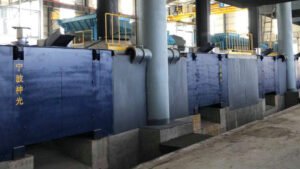
What is bottom slag?
Bottom slag refers to the slag that is deliberately placed at the bottom of the crucible before charging during the metal smelting process. This step occupies an integral position in the metal smelting process.
The existence of bottom slag is not random but is obtained through careful selection and proportioning. Its composition varies according to the specific needs of the smelting and the nature of the crucible used.
The role of bottom slag in acid crucible smelting
In the acid crucible smelting process of metal smelting, the bottom slag is mainly composed of cullet glass and fluorite, with cullet accounting for 80% and fluorite accounting for 20%. The total amount of these bottom slags accounts for about 1% to 3% of the molten steel. Once entering the melting period, the bottom slag quickly forms a protective film covering the molten steel. This protective film effectively prevents pollutants in the atmosphere from corroding molten steel and significantly reduces the oxidation of the metal.
The role of bottom slag in alkaline crucible smelting
Different from acidic crucibles, the bottom slag in alkaline crucible smelting is mainly composed of lime and fluorspar, of which lime accounts for 70% to 80% and fluorite accounts for 20% to 30%. The additional amount of these bottom slag materials also accounts for about 1% to 3% of the molten steel volume. In alkaline smelting, the bottom slag not only undertakes the similar task of protecting the molten steel from atmospheric pollution and oxidation as the acidic crucible but also has a special function – desulfurization.
The lime and fluorite in the bottom slag react chemically with the sulfur in the molten steel, precipitating the sulfur from the molten steel and forming sulfide. This desulfurization process takes place during the melting period, effectively reducing the sulfur content in the molten steel. By carefully controlling the composition and amount of bottom slag, the desulfurization effect can be maximized. After smelting is completed, the slag is removed to obtain high-quality molten steel with lower sulfur content.
The desulfurization process is as follows,
Sulfur in molten steel dissolves into slag: (Fe) + (S) = (FeS)
Desulfurization reaction takes place in the slag layer: (FeS) + (CaO) = (FeO) + (CaS)
Therefore, during the induction furnace smelting process, the bottom slag with high alkalinity not only plays a role in protecting the molten steel, but is also an important means to achieve effective desulfurization. In order to ensure the efficient progress of the smelting process and the improvement of product quality, the amount and composition of the bottom slag must be strictly controlled to ensure its optimal effect.








